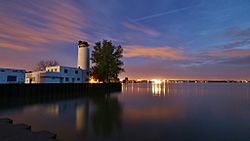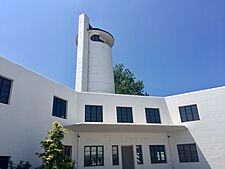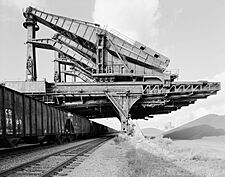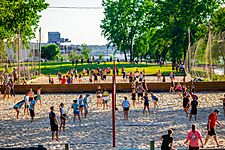Whiskey Island (Cleveland) facts for kids

Whiskey Island Coast Guard station at sunset
|
|
| Geography | |
|---|---|
| Location | North America |
| Adjacent bodies of water | Lake Erie Cuyahoga River |
| Administration | |
| State | Ohio |
| County | Cuyahoga |
| City | Cleveland |
| Neighborhood | Cuyahoga Valley |
Whiskey Island is a piece of land surrounded by water on three sides, located where the Cuyahoga River meets Lake Erie in Cleveland, Ohio. Its shape today was created in 1827 when the river's mouth was moved. This peninsula is about 1 mile (1.6 km) long and 0.3 miles (0.5 km) wide. It is bordered by Lake Erie to the north, West 54th Street to the west, and the Cuyahoga River to the south and east.
The western part of Whiskey Island is home to the Cleveland Bulk Terminal. This is a place where large amounts of materials like iron ore are loaded and unloaded from ships. The eastern part has a marina (a dock for boats) and a public park called Wendy Park. This park is part of the Lakefront Reservation, managed by the Cleveland Metroparks.
Contents
The Story of Whiskey Island
Whiskey Island has a long and interesting history, from its early days as a swampy area to becoming a busy port and a popular park.
How Whiskey Island Got Its Name
When Moses Cleaveland first explored this area in 1796, Whiskey Island was one of the few solid pieces of land among the swamps near the Cuyahoga River. A settler named Lorenzo Carter built his family farm here. The island got its name in the 1830s after a company that made alcoholic drinks was built on the site.
Early Development and Growth
The area grew a lot when the Ohio and Erie Canal was built in 1825. Many Irish immigrants moved to Whiskey Island to work on the canal and help reshape the river. In 1831, investors bought the Carter farm and divided its 80 acres (32 hectares) into plots for buildings.
Soon, factories and docks were built. The Lake Erie Iron Works made parts for steamboats and trains. There were also many saloons (places to drink) in the area. Cleveland's second hospital, called the "pest house," was built on Whiskey Island after a serious sickness called Cholera spread in 1832.
The Cleveland and Toledo Railroad (later known as the New York Central) had a train line running through Whiskey Island. Trains would stop at the river, and passengers had to take a ferry across because the city did not allow the railroad to connect to the eastbound line.
Changes in the 20th Century
As time went on, the Irish families found better jobs and homes elsewhere. Whiskey Island became mostly used by railroads and a salt mine owned by Cargill.
One important feature was the set of four huge machines called Hulett ore unloaders. These were built in 1911 at the Pennsylvania Railway Ore Dock. They were the biggest machines for unloading ore on the Great Lakes. In 2000, the Port Authority took them apart to make more space for storing materials. Two of the Huletts were recycled, and the other two were taken apart and are still on the site.
The Coast Guard built its Cleveland station on a pier north of Whiskey Island. A new station opened in 1940. The Coast Guard used this site until 1976, when they moved to a new location. The old station was empty for many years, except for a short time in the early 1990s when it was a nightclub. In 2003, the City of Cleveland bought the station for just $1. They are now planning to fix it up and use it again.
Whiskey Island Today
In the early 2000s, the Port Authority wanted to buy the eastern part of Whiskey Island to make the port bigger. However, they did not buy the land. Instead, Cuyahoga County bought the open space and marina in 2004. They wanted to keep it as a public park.
This was largely thanks to the efforts of an activist named Ed Hauser, who was known as the "Mayor of Whiskey Island." Wendy Park at Whiskey Island opened to the public in 2005. It has sand volleyball courts, a beautiful prairie garden, and a restaurant-bar. In 2014, the Cleveland Metroparks bought Whiskey Island.
Wendy Park has become very popular. About 7,000 people visited in 2005, and by 2010, that number grew to over 180,000 visitors!




